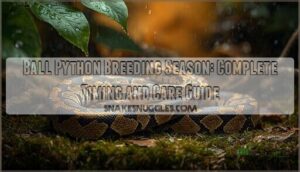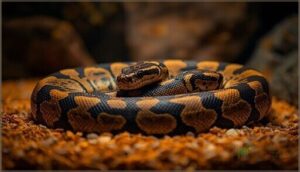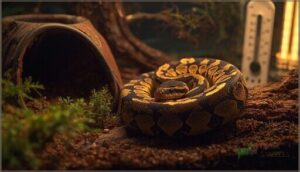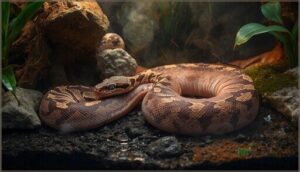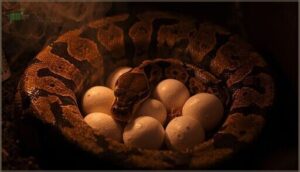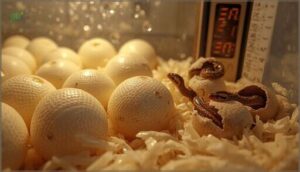This site is supported by our readers. We may earn a commission, at no cost to you, if you purchase through links.
A ball python’s breeding season isn’t dictated by the calendar—it’s orchestrated by subtle cues you can’t spot on a thermometer alone. In the wild, these snakes sync their rhythms to the West African rains, waiting for the world to shift before shifting their own.
Captive keepers, though, learn to mimic the dance: adjusting temperatures, dimming lights, and reading restless males or a hungry, swelling female as signs of readiness.
Mastering ball python breeding season means understanding not just when, but why these signals matter—and using that knowledge to guide every decision from pairing to hatchling care.
Table Of Contents
- Key Takeaways
- Ball Python Breeding Season Overview
- Preparing Ball Pythons for Breeding
- Pairing and Mating Behavior
- Ovulation, Egg Laying, and Pre-Lay Shed
- Egg Incubation and Hatchling Care
- Frequently Asked Questions (FAQs)
- How to tell if your ball python is ready to breed?
- Do ball pythons stop eating during mating season?
- How to tell if a ball python is ovulating?
- What is the seasonality of a ball python?
- What months do ball pythons breed?
- How do you know when a ball python is ready to breed?
- Can you breed ball pythons all year round?
- How does climate affect ball python breeding cycles?
- What role do pheromones play in ball python mating?
- How often can a female ball python safely reproduce?
- Conclusion
Key Takeaways
- Ball pythons don’t follow strict calendar-based breeding seasons in captivity—you can trigger reproduction year-round by manipulating temperature (dropping to 76-77°F ambient), photoperiod (14 hours darkness), and humidity (70-80%), though most breeders pair November through March for spring clutches.
- Females must reach at least 1,500 grams (ideally 1,800g) and experience 2-3 winters before breeding, while males can start around 800 grams at one year—body condition matters more than age alone, and pre-breeding health checks with fecal analysis prevent reproductive failure.
- The pre-lay shed occurring roughly 2-3 weeks post-ovulation is your most reliable timeline marker, signaling eggs will arrive in 21-45 days (typically 30), after which you’ll need incubation at 88-90°F and near 100% humidity for 55-65 days until hatching.
- Males commonly service 3-6 females per season but require rest periods between pairings to avoid over-breeding, while a single successful copulation lock can produce fertile clutches due to sperm retention—quality trumps quantity in pairing frequency.
Ball Python Breeding Season Overview
Ball pythons don’t follow a strict calendar for breeding—they’re far more flexible than most people realize. While wild populations in West Africa sync their reproductive cycles with seasonal rainfall and prey availability, captive ball pythons can breed nearly year-round under the right conditions.
Understanding these timing differences and the environmental cues that trigger breeding behavior will help you plan your breeding season with confidence.
Timing of Breeding Season in Captivity
In captivity, your ball python’s breeding season generally spans September through March, though year-round breeding is absolutely achievable without seasonal temperature drops. Most breeders initiate pairing in late November, aiming for first copulation locks by January.
Clutch deposition timing is concentrated between April and June, with some females laying eggs as late as September. According to research, ultrasonographic exams can help monitor follicle growth.
Males often fast for two months post-breeding, while females generally maintain feeding throughout the cycle.
Seasonal Triggers and Environmental Cues
To trigger breeding season reliably, you’ll need to replicate the seasonal changes your ball pythons would encounter in their equatorial habitat. Temperature cycling involves dropping the hot spot from 90°F to 88°F and the ambient temperature from 82°F down to 76-77°F. The photoperiod impact shifts the lighting to 14 hours of darkness and 10 hours of light, starting in October. Humidity influence increases to 70-80% during the breeding months, stimulating reproductive behavior through three key environmental cues:
- Temperature drops that lower nighttime enclosures to 75-78°F
- Shorter photoperiods mimicking dry-season light patterns
- Elevated humidity replicating rainy conditions that trigger mating
Behavioral cues follow these adjustments—males become restless, while females increase their appetite before ovulation. Seasonal changes are important for captive ball pythons. Seasonal alignment with cooling mimics Africa’s wet-dry transitions, promoting follicle production and copulation rates.
Differences Between Wild and Captive Cycles
While those seasonal changes work well in captivity, wild seasonality differs sharply from your captive environment. In West Africa, ball pythons mate September through November during minor rains, then females lay eggs February to April—hatching aligns with wet-season prey peaks in April to June.
Captive breeding flips this timeline entirely: you’ll see most clutches October through December under environmental control, creating reproductive pacing and clutch variation that don’t match native patterns.
Preparing Ball Pythons for Breeding
Successful breeding starts well before you introduce a male to a female. You’ll need to evaluate whether your snakes are physically ready, prepare them through seasonal cycling, and make sure they’re in peak health.
Let’s break down each step so you can set up your breeding program with confidence.
Assessing Age, Weight, and Body Condition
Before you breed ball pythons, determining breeding readiness means looking beyond the calendar. Females should reach at least 1,500 grams—ideally closer to 1,800—and have experienced two to three winters. Males can start around 800 grams at roughly one year old.
Body scoring reveals more than weight alone: you want a well-rounded physique, not obesity.
Ultrasound use helps confirm follicle development, giving you confidence in timing and health impacts.
Seasonal Cycling Techniques
Beginning in October, you’ll drop hot spot temperatures to 82°F and cool ends to 78°F, establishing a 14-hour dark photoperiod. Maintain this three-month cooling period with 60-70% humidity.
As March approaches, gradually raise temperatures 1°C daily back to 92°F. This seasonal cycling for breeding readies follicular development and males at 800g and females over 1,500g for successful breeding cycle initiation.
Health and Nutritional Considerations
Your female’s minimum weight of 1,500 grams determines breeding success, while males need 700 grams for reliable performance.
Schedule pre-breeding exams detecting parasite risks through fecal analysis, and establish feeding schedules providing appropriately-sized prey every 7-10 days. Monitor feeding response carefully—snakes going off feed signal stress or illness affecting ball python health.
Maintain environmental health with 88-92°F temperatures and 50-60% humidity, supporting best ball python care and animal health throughout breeding preparation.
Pairing and Mating Behavior
Once you’ve cycled your ball pythons and confirmed they’re in breeding condition, it’s time to introduce your pairs and watch for the behaviors that signal successful copulation.
Understanding what happens during courtship—and how often to rotate males through your breeding groups—will help you increase fertility while keeping your animals healthy.
Let’s walk through the practical steps of pairing, the signs that tell you mating is occurring, and how to manage multiple breedings throughout the season.
Introducing Males to Females
You’ll need to place the male directly into the female’s enclosure, not the other way around—her pheromones concentrate there, triggering his courtship response more reliably.
Most breeders start introductions between November and February, keeping males with females for 2–3 days per cycle. During pairing duration, aim for 3–5 confirmed locks across the season.
Evening introduction timing aligns with peak activity, boosting engagement rates considerably.
Courtship and Copulation Signs
Locked in a subtle dance, ball pythons broadcast interest through tactile courtship—prolonged body contact, tail alignment, and persistent gentle pressure. Males ramp up tongue-flicking, following chemical signals released in her enclosure.
When copulation occurs, pairs may remain entwined for hours or more, with social context and proper courtship alignment setting the stage for multiple, reliable locks throughout breeding season.
Breeding Frequency and Male Rotation
Striking the right balance in pairing ratios is essential if you want healthy, productive ball pythons all season. Males commonly service 3–6 females, but scheduling male rest after each session helps avoid over-breeding risks.
Smart rotation—with breaks and feeding—protects rotation health, while sperm retention means a single lock can yield fertile clutches, streamlining pairing without straining your males.
Ovulation, Egg Laying, and Pre-Lay Shed
Getting to know the signs of ovulation, egg laying, and the pre-lay shed is key for planning your next steps. Each stage brings its own set of behaviors and enclosure needs.
Here’s what you should be looking for as you set up the right environment.
Detecting Ovulation and Behavioral Changes
Spotting ovulation in ball pythons means reading subtle cues: watch for Cool-Seeking Behavior, swelling beyond mid-body, and sudden Handling Aversion. Nesting Preparation—like restless bedding rearrangement—signals you’re close. Palpation Methods confirm follicles, while Color Changes, sometimes dubbed “glowing,” mark oncoming changes. The ball python’s behavior shifts noticeably here, setting the stage for the essential prelay shed.
Pre-Lay Shed Cycle
Once you’ve spotted ovulation, the pre-lay shed arrives roughly two to three weeks later—your most reliable signal that eggs are coming. During this shedding duration, your female ball python‘s skin dulls, eyes cloud blue, and physiological changes intensify: swelling peaks, belly pinks up, appetite drops. Behavioral indicators like restless nesting confirm what’s next.
Husbandry factors matter now—bump humidity to 70–80% for a clean shed and smooth ovulation relation to laying.
Egg Laying Timeline and Behaviors
After the pre-lay shed, expect eggs about 30 days later—though you’ll see anywhere from 21 to 45 days in real breeding records. As that window closes, your female will stop eating entirely, prowl for the warmest nesting site (usually 88–90°F), and coil tight over the spot.
Laying Process Duration runs 4–8 hours overnight; by morning, you’ll find a cohesive egg mass formation and a fiercely protective coil.
Egg Incubation and Hatchling Care
Once your female lays her clutch, your attention shifts to creating the right incubation conditions and preparing for hatchlings. Getting temperature, humidity, and substrate dialed in now determines whether those eggs develop properly over the next two months.
Here’s how to set up your incubator, monitor fertility, and care for baby ball pythons from day one.
Setting Up The Incubation Environment
Once your female lays her clutch, you’ll need a reliable incubator to maintain ideal conditions for the next 55–65 days. Temperature stability is your first priority—target 90°F to avoid developmental issues, though incubation at 88°F works well. Humidity control inside sealed egg boxes should reach 99–100% to prevent desiccation.
Here’s how to set up your egg incubation environment:
- Choose your Substrate Selection wisely—perlite at a 1:1 water ratio or Hatchrite medium fills your Egg Box Design to 1–2 inches depth and holds moisture evenly throughout incubation.
- Seal boxes with Press-n-Seal—this simple step sustains near 100% humidity inside for 60 days without constant adjustments.
- Use DIY Incubators if budget matters—70-quart coolers wrapped with Flex Watt heat tape and controlled by a BAH-1000 thermostat assemble in 30 minutes and work as reliably as commercial units.
- Monitor with hygrometers and thermometer probes—insert probes 2–3 inches into the incubator to track conditions accurately and catch fluctuations before they cause problems.
- Warm up your vermiculite or perlite medium for 24 hours post-setup—thermal equilibrium ensures stable conditions the moment you transfer eggs from the laying bin.
Monitoring Egg Development and Fertility
Once your incubation process begins, egg candling becomes your best diagnostic tool. Start candling every 3–5 days from day seven to catch fertility indicators early—fertile eggs show vascular networks and opacity, while infertile eggs stay yellow and translucent. Ultrasound imaging can detect embryo movement and shell structure. Maintaining environmental stability at 88–90°F and 50–60% humidity is crucial for protecting egg development. Intervention strategies involve removing non-viable eggs immediately to prevent fungal spread.
| Monitoring Method | What You’ll See |
|---|---|
| Candling fertile eggs | White, opaque, blood vessels visible |
| Candling infertile eggs | Yellow, translucent, no vascular development |
| Ultrasound imaging | Double-layer shell structure, embryo movement |
Caring for Newly Hatched Ball Pythons
After your hatchlings pip and emerge—usually around day 55—they’ll absorb their yolk sacs and require no feeding for 7–10 days. Ball python baby care starts with proper housing:
- Use enclosures under 25 gallons with secure lids
- Maintain temperature gradients of 90°F warm side to 78°F cool side
- Keep humidity control between 50–60% to prevent dysecdysis
- Offer the first meal (mouse hopper) after their initial shed
- Monitor for common ailments like respiratory infections and mites
Setting up baby snakes correctly ensures healthy growth trajectories.
Frequently Asked Questions (FAQs)
How to tell if your ball python is ready to breed?
Think of readiness as a three-legged stool: weight benchmarks, body condition, and behavioral cues.
Assess females for solid muscle, healthy weight, active follicle development, and lack of risk factors before pairing.
Watch for males showing breeding season activity.
Do ball pythons stop eating during mating season?
During snake breeding, Male Fasting is common—he may go off feed for months during active courtship.
Female Appetite stays steady until ovarian development peaks, then breeding anorexia sets in during late-season ovulation in female ball python breeding.
How to tell if a ball python is ovulating?
You’ll notice ovulation swelling—an abrupt, football-shaped bulge in the female’s midsection, distinct tail changes, feeding decline, and a preference for the warm side.
Ultrasound indicators confirm follicles at 40–45 mm, which signals imminent pre-lay shed.
What is the seasonality of a ball python?
Paradoxically, ball python breeding thrives on both change and constancy. Wild seasonality is tied to temperature, photoperiod, and humidity cycles, but in captivity, breeding season management relies on artificially constructed cues, enabling greater flexibility in seasonal cycling for breeding.
What months do ball pythons breed?
Ball pythons are most often paired in captivity between November and March, but Breeding Month Variation means viable pairings or clutches can occur year-round.
Wild Breeding Months tend to cluster September–November, with Captive Breeding Peaks usually in spring.
How do you know when a ball python is ready to breed?
Think of a lock and its key—weight benchmarks, age considerations, and solid body condition are your clue that females are close to pairing success.
Look for behavioral cues, like increased activity, and track ovulation and pre-lay shed.
Can you breed ball pythons all year round?
You can breed ball pythons year-round in captivity, but true success combines environmental control with strict attention to health, body condition, and breeding frequency.
Consistent nutrition and selective seasonal cycling for breeding often improve outcomes across the entire ball python breeding cycle.
How does climate affect ball python breeding cycles?
Like tuning an instrument, climate shapes the Ball Python Breeding Cycle. Temperature influence and rainfall effects in West and Central Africa act as seasonal cues.
Humidity impact and climate change directly affect reproductive timing, follicle growth, and success in seasonal cycling for breeding.
What role do pheromones play in ball python mating?
Pheromones guide the snake breeding process by enabling precise Mate Location and signaling Reproductive Status.
Through Sensory Detection, males follow female scent trails, adjust Courtship Signals, and navigate Male Competition—shaping snake behavior and communication in every encounter.
How often can a female ball python safely reproduce?
Females can safely breed once per year, though alternating years—one season on, one off—promotes better body condition and longevity.
Let her regain body weight fully between clutches to sustain long-term reproductive span.
Conclusion
Think of yourself as a conductor—not inventing the music, but bringing every instrument into harmony at the right moment. Ball python breeding season demands that same precise orchestration: temperature drops, light shifts, body condition assessments, and behavioral cues all converging into successful reproduction.
You don’t control nature, but you learn its language. Master those signals, respect the timeline, and you’ll guide your pythons through breeding with confidence, consistency, and care that mirrors their wild rhythms.

